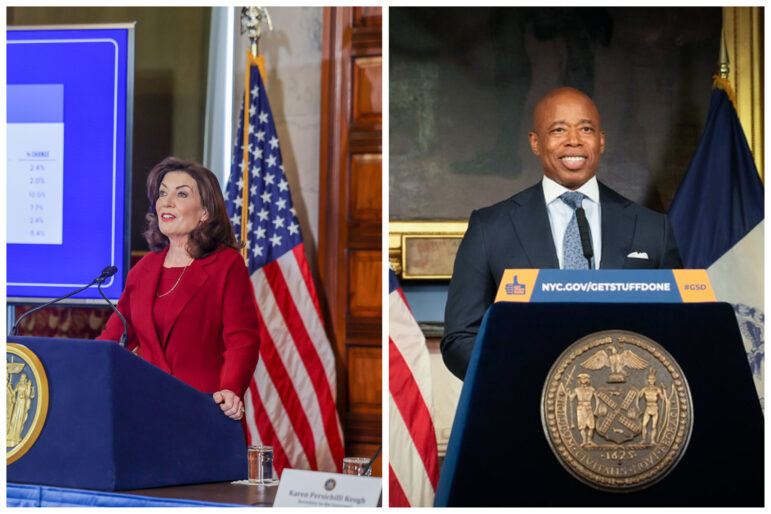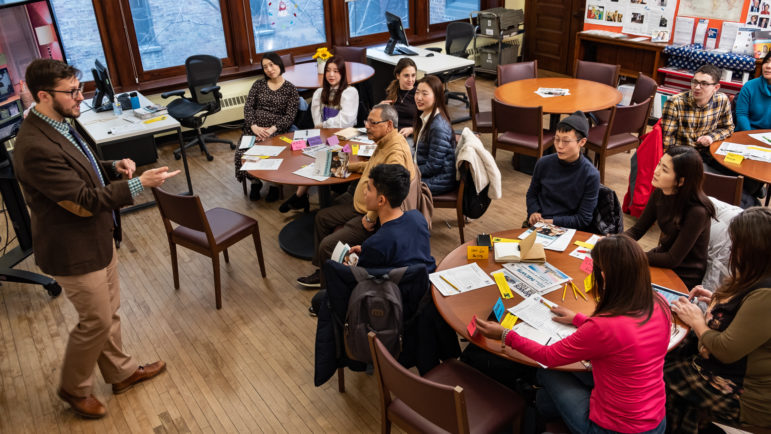Advocates are sounding the alarm over both Gov. Hochul and Mayor Adams’ spending proposals, which failed to include several flagship programs they’ve fought for in recent years as well as reductions to programs that provide English language, literacy and citizenship classes that immigrant New Yorkers rely on.

Mike Groll/Office of Governor Kathy Hochul;Michael Appleton/Mayoral Photography Office
Gov. Kathy Hochul and Mayor Eric Adams presenting their budget plans for Fiscal Year 2024.Lea la versión en español aquí.
Another year has begun and the budgets for both New York City and State are on the negotiating table again. Mayor Eric Adams and Gov. Kathy Hochul each recently released their spending plans, and so far, advocates and immigrant rights organizations say they are disappointed and concerned about the lack of resources included for immigrant communities.
Hochul failed to include major programs that advocates have been pushing for, such as bills to offer health care or mental health coverage, statewide legal representation in deportation proceedings and unemployment insurance to undocumented immigrants. On the city level, advocates decried proposed cuts to libraries and resources for programs that many immigrant New Yorkers rely on, such as adult literacy and English language classes.
The omissions are particularly glaring, they say, in light of the tens of thousands of new immigrants who’ve arrived in the city over the last several months seeking asylum from the southern border.
“I can’t stress how disappointed I am,” said Theodore Moore, New York Immigration Coalition’s vice president of policy and programs.
City cuts to adult literacy programs
Mayor Eric Adams’ preliminary budget landed with much criticism from advocates, especially proposed cuts to adult literacy programs, which benefit thousands of immigrants in the five boroughs.
The most drastic cut is in funding earmarked for “Adult Literacy Expansion,” which shrinks from $18,786,700 in the current fiscal year to only $5,915,376 for Fiscal Year 2024. Another batch of funding set aside for adult education—under the “Adult Ed Act”—would go from $3,046,984 to $1,050,322. In total, the city’s adult literacy programs would see a cut from $24 million to $9 million.
Those cuts, said Liza Schwartzwald, senior manager of economic justice and family empowerment at the New York Immigration Coalition, “are most likely to affect the amount of money available for the upcoming adult literacy Request for Proposals, which will govern contracts for adult literacy programs for at least the next five years.”
“Adult Literacy programs have been underfunded for years, with the cost of quality services running at about [four times] the average currently available rate per student,” she added. “The proposed cuts walk back years of advocacy and program wins meant to expand and bolster these highly needed programs.”
The reduction will worsen what’s already a shortage: Fewer than 4 percent of the adults who could benefit from adult education classes in New York are able to access seats in any given year, according to the NYC Coalition for Adult Literacy (NYCCAL).
The Chinese-American Planning Council (CPC), one of dozens of organizations that offer adult education courses, including citizenship preparation and English as a second language (ESOL) classes, served more than 800 immigrants during the last fiscal year, which ended in June 30.
“We are on track to surpass last year’s numbers, highlighting the increasing need for these services in our immigrant communities,” said Jeff Lau, CPC’s adult literacy director. Funding cuts would impact the organization’s ability to staff “wrap around services” offered to students outside the classroom, like counseling.
“More importantly, students’ lives will be put on hold as people wait to achieve a high school equivalency, enter the workforce, assist in their children’s homework, or become a U.S. citizen,” Lau added.
The city’s public libraries, which serve thousands of immigrant students per year, also face budget cuts. Funding slashed from the city’s three library systems (Brooklyn, Queens, and New York) from the modified November budget remained in the mayor’s preliminary budget released in January, what the city’s comptroller said totals $13.6 million for the current fiscal year and a $20.5 million loss by FY2026.
“The budget cuts proposed by the administration would undoubtedly impact programs and services at BPL, including those for immigrant communities,” Brooklyn Public Library (BPL) Spokesperson Fritzi Bodenheimer said. From January 2019 to December 2022, BPL provided 4,700 sessions of English classes with a total attendance of 50,800 students, and 1,114 citizenship classes with 7,400 total attendance.
Similarly, between 2019 and 2023, the New York Public Library—which operates branches in Manhattan, The Bronx and Staten Island—offered nearly 90,000 ESOL seats and 11,000 seats for citizenship classes.

Adi Talwar
A drop-in English conversation class at the St. Agnes branch of the New York Public Library in the Upper West Side in January 2020.
For Queens Public Library (QPL), the budget cuts would mean a $10.3 million reduction, said Ewa Kern-Jedrychowska, the deputy communications director. QPL offered 329,903 seats for ESOL classes and 13,311 seats for citizenship classes from 2019 to 2022.
“We continue to identify ways to minimize the impact, but cuts of this magnitude would result in reduced service,” Kern-Jedrychowska said.
Mayor Adams has defended his budget plan as what the city needs to maintain services while still practicing “fiscal discipline.”
“We crafted this budget in an environment of economic and fiscal uncertainty,” the mayor said at budget briefing in January, pointing to the ongoing economic impact of the COVID-19 pandemic, including slowing real estate sales and rising interest rates.
“These are tough times and I can’t tell you how many times my deputy mayors have knocked on the door and said, ‘Well, can we spare this agency? Can we spare that agency?'” Adams said when asked about library spending specifically. “We have to send a strong message that we must find more efficient ways of running our city.”
Adult education cuts may be coming from the state, too. In 2023, the legislature added $1.5 million to these programs on a one-time basis, and this year advocates are pushing for this addition to be included once again, or increased. According to NYCCAL, there are 3.9 million adults with limited English proficiency or without a high school diploma in New York State.
“Without adequately funded adult literacy programs, immigrants with low English proficiency are completely cut out of their communities,” Schwartzwald said. “They cannot find work, cannot communicate with their doctors, cannot assist their children with schoolwork or attend a parent-teacher conference.”
NYS’ $1 billion budget funding, unpacked
Gov. Kathy Hochul pledged more than $1 billion in her executive budget to assist new immigrants and asylum seekers, while calling on the federal government to match the funds and proposing an even split of costs between the city, state and Washington.
The state’s $1 billion contribution is intended to reimburse programs that have already been implemented, as well as for future programs. The governor’s press office explained that more than 70 percent of the money, $767 million, will go to reimburse the city’s spending on shelter and services for asylum seekers.
There’s been much speculation about the actual price tag for what the city is spending on shelter and services for migrants, which has included the opening of several emergency “humanitarian relief” centers, or HERCCs. “$1.4 billion this fiscal year, 2.8 the next. Those are the numbers,” Adams said at a City Hall press conference earlier this month, noting that the figure continues to shift as more migrants arrive. An internal administration memo, obtained and first reported by Politico, said Adams estimates spending as much as $4.2 billion on asylum seekers by the end of the next fiscal year.

Michael Appleton/Mayoral Photography Offic
A city-run emergency shelter for asylum seekers set up at the Brooklyn Cruise Terminal in Red Hook.Avi Small, Hochul’s first deputy press secretary, said city will ultimately decide how to use the state aid, but expects most will go to the city’s Department of Homeless Services, since more asylum seekers are currently being sheltered in DHS facilities than in the HERRCs (which are managed by the city’s Office of Emergency Management).
Adams is scheduled to testify before lawmakers in Albany Wednesday about the city’s budget needs. Since last year, the mayor has been calling for the state and federal government to tripartite spending on asylum seekers, although at a recent press conference, said this idea no longer seems realistic under a Republican-majority House of Representatives.
“If we’re counting on that 30 percent split, that just doesn’t add up,” Adams said, doubting that the city could be getting more than the approximately $800 million already earmarked from Washington.
In addition to the money for sheltering migrants, the governor’s budget directs $162 million for the National Guard, which currently has more than 900 members deployed in New York City, providing operational and logistical support. This would be money for reimbursement and for future operations, the state clarified, without giving details on how much has been spent so far.
The National Guard’s role at the Port Authority Bus Terminal, Small explained, is to greet migrants arriving on buses from the border, answer questions and direct them to services, including transportation options.
Hochul’s budget also sets aside $137 million in support of the city’s NYC Care initiative, a healthcare program for low-income and non-citizen New Yorkers who do not qualify for or cannot afford other coverage.
But advocates are disappointed the governor did not embrace several high-priority legislative items they have asked for for years, like making undocumented people eligible for the New York Essential Plan, the state’s health care program for low-income residents.
Make the Road New York’s Deputy Director Becca Talzek said that Gov. Hochul pledged during last year’s budget to ask the federal government to fund that expansion, which would open up coverage for undocumented persons between the ages of 19 and 64 who are currently ineligible for Medicaid and other low-cost government insurance plans.
Moreover, the smaller expansion that Hochul did agree to last year—expanding Medicaid to include undocumented immigrants over 65, and new mothers—has also not been implemented yet, and will now start in 2024 instead of January 2023, as initially planned, according to reporting from New York Focus.
Hochul’s budget proposes $25 million for asylum seekers’ resettlement assistance, an expansion of the services provided to refugees by the state’s Office of Temporary and Disability Assistance (OTDA). Funding distributed by OTDA to local non-profit organizations would cover the cost of housing for up to one year for families who choose to relocate, as well as provide wrap-around case management services in their new location.
The governor has allocated another $43 million for the NYS Office for New Americans (ONA), including $10 million for its Liberty Defense Project, which provides free legal assistance to immigrants across the state.
But immigrant rights groups and local lawmakers want to see a bigger investment on that front: Advocates like the New York Immigration Coalition are calling on the governor to invest $100 million to implement the Access to Representation Act, which would give low-income immigrants guaranteed access to attorneys in immigration proceedings.
Existing backlogs in New York’s immigration courts have been exacerbated by the arrival of new immigrants in recent months, and the demand for legal services has skyrocketed, elected officials said. Heading to immigration court without an attorney can have dire results for immigrants: Past studies of right-to-counsel programs have found that represented immigrants were four times more likely to win release from detention, and over 10 times more likely to prove their right to remain in the United States.
“If they cannot afford a lawyer, they are left to fight a complex immigration system on their own,” State Assemblywoman Catalina Cruz, one of the bill’s sponsors, said at a rally Tuesday calling on the governor to support the legislation.








